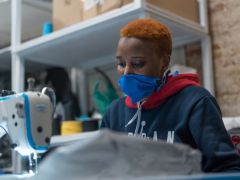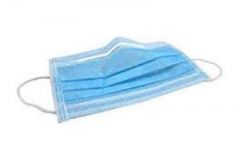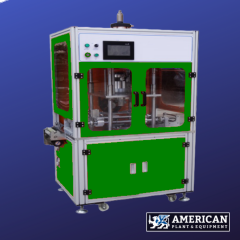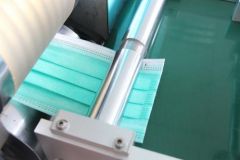Search results for: 'lin'
- Related search terms
- line
- Line b
- Line bleach
- Line bleach co
- link check
-
 D-2388 What’s the Best Material for a Mask?
D-2388 What’s the Best Material for a Mask?Federal health officials have now recommended that we cover our faces with fabric during the coronavirus pandemic. But what material offers the most protection?
The Centers for Disease Control and Prevention has posted a no-sew mask pattern using a bandanna and a coffee filter as well as a video on making masks using rubber bands and folded fabrics found at home.
While a simple face covering can reduce the spread of coronavirus by blocking outgoing germs from coughs or sneezes of an infected person, experts say there is more variation in how much homemade masks might protect the wearer from incoming germs, depending on the fit and quality of the material used.
Scientists around the country have taken it upon themselves to identify everyday materials that do a better job of filtering microscopic particles. In recent tests, HEPA furnace filters scored well, as did vacuum cleaner bags, layers of 600-count pillowcases and fabric similar to flannel pajamas. Stacked coffee filters had medium scores. Scarves and bandanna material had the lowest scores, but still captured a small percentage of particles.
If you don’t have any of the materials that were tested, a simple light test can help you decide whether a fabric is a good candidate for a mask.
“Hold it up to a bright light,” said Dr. Scott Segal, chairman of anesthesiology at Wake Forest Baptist Health who recently studied homemade masks. “If light passes really easily through the fibers and you can almost see the fibers, it’s not a good fabric. If it’s a denser weave of thicker material and light doesn’t pass through it as much, that’s the material you want to use.”
Researchers say it’s important to remember that lab studies are conducted under perfect conditions with no leaks or gaps in the mask, but the test methods give us a way to compare materials. And while the degree of filtration for some homemade masks seems low, most of us — who are staying home and practicing social distancing in public — don’t need the high level of protection required for medical workers. More important, any face covering is better than none, especially if worn by a person who has the virus but doesn’t know it.
The biggest challenge of choosing a homemade mask material is to find a fabric that is dense enough to capture viral particles, but breathable enough that we can actually wear it. Some items being touted online promise high filtration scores, but the material would be unwearable.
Dressing Up for Work … at Home
Yang Wang, an assistant professor of environmental engineering at Missouri University of Science and Technology, worked with his graduate students to study various combinations of layered materials — including both air filters and fabric. “You need something that is efficient for removing particles, but you also need to breathe,” said Dr. Wang, who last fall won an international award for aerosol research.To test everyday materials, scientists are using methods similar to those used to test medical masks, which everybody agrees should be saved for medical workers who are exposed to high doses of virus from seeing infected patients. The best medical mask — called the N95 respirator — filters out at least 95 percent of particles as small as 0.3 microns. By comparison, a typical surgical mask — made using a rectangular piece of pleated fabric with elastic ear loops — has a filtration efficiency ranging from 60 to 80 percent.
Dr. Wang’s group tested two types of air filters. An allergy-reduction HVAC filter worked the best, capturing 89 percent of particles with one layer and 94 percent with two layers. A furnace filter captured 75 percent with two layers, but required six layers to achieve 95 percent. To find a filter similar to those tested, look for a minimum efficiency reporting value (MERV) rating of 12 or higher or a microparticle performance rating of 1900 or higher.
The problem with air filters is that they potentially could shed small fibers that would be risky to inhale. So if you want to use a filter, you need to sandwich the filter between two layers of cotton fabric. Dr. Wang said one of his grad students made his own mask by following the instructions in the C.D.C. video, but adding several layers of filter material inside a bandanna.
Dr. Wang’s group also found that when certain common fabrics were used, two layers offered far less protection than four layers. A 600 thread count pillow case captured just 22 percent of particles when doubled, but four layers captured nearly 60 percent. A thick woolen yarn scarf filtered 21 percent of particles in two layers, and 48.8 percent in four layers. A 100 percent cotton bandanna did the worst, capturing only 18.2 percent when doubled, and just 19.5 percent in four layers.
The group also tested Brew Rite and Natural Brew basket-style coffee filters, which, when stacked in three layers, showed 40 to 50 percent filtration efficiency — but they were less breathable than other options.
If you are lucky enough to know a quilter, ask them to make you a mask. Tests performed at the Wake Forest Institute for Regenerative Medicine in Winston-Salem, N.C., showed good results for homemade masks using quilting fabric. Dr. Segal, of Wake Forest Baptist Health, who led the study, noted that quilters tend to use high-quality, high-thread count cotton. The best homemade masks in his study were as good as surgical masks or slightly better, testing in the range of 70 to 79 percent filtration. Homemade masks that used flimsier fabric tested as low as 1 percent filtration, Dr. Segal said.
The best-performing designs were a mask constructed of two layers of high-quality, heavyweight “quilter’s cotton,” a two-layer mask made with thick batik fabric, and a double-layer mask with an inner layer of flannel and outer layer of cotton.
Bonnie Browning, executive show director for the American Quilter’s Society, said that quilters prefer tightly woven cottons and batik fabrics that stand up over time. Ms. Browning said most sewing machines can handle only two layers of fabric when making a pleated mask, but someone who wanted four layers of protection could wear two masks at a time.
Ms. Browning said she recently reached out to quilters on Facebook and heard from 71 people who have made a combined total of nearly 15,000 masks. “We quilters are very much in the thick of what’s going on with this,” said Ms. Browning, who lives in Paducah, Ky. “One thing most of us have is a stash of fabric.”
People who don’t sew could try a folded origami mask, created by Jiangmei Wu, assistant professor of interior design at Indiana University. Ms. Wu, who is known for her breathtaking folded artwork, said she began designing a folded mask out of a medical and building material called Tyvek, as well as vacuum bags, after her brother in Hong Kong, where mask wearing is common, suggested it. (DuPont, the maker of Tyvek, said in a statement that Tyvek is intended for medical apparel, not masks.) The folded mask pattern is free online, as is a video demonstrating the folding process. In tests at Missouri University and University of Virginia, scientists found that vacuum bags removed between 60 percent and 87 percent of particles. But some brands of vacuum bags may contain fiberglass or are harder to breathe through than other materials, and shouldn’t be used. Ms. Wu used a bag by EnviroCare Technologies, which has said it does not use fiberglass in its paper and synthetic cloth bags.
“I wanted to create an alternative for people who don’t sew,” said Ms. Wu, who said she is talking to various groups to find other materials that will be effective in a folded mask. “Given the shortage of all kinds of materials, even vacuum bags might run out.”
The scientists who conducted the tests used a standard of 0.3 microns because that is the measure used by the National Institute for Occupational Safety and Health for medical masks.
Linsey Marr, a Virginia Tech aerosol scientist and an expert in the transmission of viruses, said the certification method for respirators and HEPA filters focuses on 0.3 microns because particles around that size are the hardest to catch. While it seems counterintuitive, particles smaller than 0.1 microns are actually easier to catch because they have a lot of random motion that makes them bump into the filter fibers, she said.
“Even though coronavirus is around 0.1 microns, it floats around in a wide range of sizes, from around 0.2 to several hundred microns, because people shed the virus in respiratory fluid droplets that also contain lots of salts and proteins and other things,” said Dr. Marr. “Even if the water in the droplets fully evaporates, there’s still a lot of salt and proteins and other gunk that stays behind as solid or gel-like material. I think 0.3 microns is still useful for guidance because the minimum filtration efficiency will be somewhere around this size, and it’s what NIOSH uses.”
Learn More -
 J-2795 DISPOSABLE FACE MASKS, 3-PLY SPUNBOND-MELTBLOWN-SPUNBOND, 50 PIECES PER BOX
J-2795 DISPOSABLE FACE MASKS, 3-PLY SPUNBOND-MELTBLOWN-SPUNBOND, 50 PIECES PER BOXDISPOSABLE FACE MASKS
MATERIAL: 3-PLY (100% VIRGIN FIBER)
1ST LAYER NONWOVEN PP SPUNBOND
2ND LAYER NONWOVEN PP MELTBLOWN
3RD LAYER NONWOVEN PP SPUNBOND
MASK SIZE: 175mm x 95mm (ADULT SIZE)
WEIGHT: 2.9 TO 3.2 GRAMS EACH
50 PIECES PER BOX / 40 BOXES PER CARTON
• LOW BREATHING RESISTANCE
• SOFT LINING, NON-IRRITATING TO SKIN
• FIBERGLASS FREE AND LATEX FREE
• WITH ADJUSTABLE NOSE BRIDGE SUPPORT PIECE
• WITH ELASTIC EAR LOOPSQUANTITY: 50,000 PIECES OF FRESH STOCK CURRENTLY AVAILABLE
Learn More -
 V-1816 AUTOMATIC RESPIRATOR REPLACEMENT FILTER MAKING MACHINE
V-1816 AUTOMATIC RESPIRATOR REPLACEMENT FILTER MAKING MACHINEAUTOMATIC RESPIRATOR REPLACEMENT FILTER MAKING MACHINE IS ALSO CALLED A PARTICULATE RESPIRATOR FILTER MAKING MACHINE OR HALF FACE RESPIRATOR FILTER MAKING MACHINE, IT’S MADE UNDER MATURE TECHNOLOGY THAT SUPPORTS AUTOMATICALLY MATERIAL FEEDING, WELDING, PUNCHING AND CUTTING, REPLACEMENT FILTER FORMING, THIS MACHINE IS EASY TO OPERATE, BY CHANGING THE ROLLER, IT CAN PRODUCE DIFFERENT SHAPES OF FILTER. THIS MACHINE INCORPORATES ADVANCED ULTRASONIC WELDING AND EQUIPPED WITH CONSTANT TEMPERATURE CONTROLLER WHICH ENSURES THE FILTER FIRMLY AND CLEARLY WELDED.
FEATURES:
1. ADVANCED ULTRASONIC TECHNOLOGY WITH FIRM WELDING EFFECT, IT’S EQUIPPED WITH PULL AND PUSH TYPE MATERIAL FEEDING WHICH MAKES IT EASIER OPERATING.
2. THE MOLD (PATTERN ROLLER) CAN BE CUSTOMIZED TO PRODUCE DIFFERENT FILTERS.
3. THE WELDING LINE IS CLEAR AND FIRM.
ITEM NAME
TECHNICAL PARAMETERS
QTY
REMARK
SPECIFICATION
1800mm X 1200mm X 1800mm
1
HONGDA
WEIGHT
500KG
EFFICIENCY
20 TO 30PCS/MIN
VOLTAGE
220V/380V
AIR PRESSURE
3-6KG/CM²
FREQUENCY
15/20KHZ
POWER
4200W
MOLD SERVO MOTOR
SGM7G-09AFC61 4.4KW
1
YASKAWA
ULTRASONIC POWER SERVO MOTOR
SGM7G-13AFC61 1.3KW
2
YASKAWA
MATERIAL PULLING SERVO MOTOR
SGM7G-09AFC61 0.85KW
2
YASKAWA
MATERIAL FEEDING/CORRECTING/INDENTATION MOTOR
130BYG-350A
4
SONGYANG
POUCHING MOTOR
110BYG-350B
4
SONGYANG
110 STEPPER MOTOR
110BYG-350A
10
SONGYANG
UP AND LOWER MOTOR
90BYG-350A
2
SONGYANG
STEPPER MOTOR 56
SY57STH56-2004A
8
SONGYANG
DIRECT CURRENT MOTOR
0.4KW
2
DIRECT CURRENT MOTOR
0.6KW
1
ASYNCHRONOUS THREE-PHASE MOTOR
90S-6
1
0.75KW
FREQUENCY CONVERTER
AVF200-0152
1
1.5KW
MAIN PNEUMATIC COMPONENTS: AIRTAC (TAIWAN); MAIN ELECTRICAL COMPONENTS: PANASONIC (JAPAN), SICK (GERMANY), DONLIM (CHINA&JAPAN), ETC.
EMAIL US FOR PRICE & PICTURES
INCLUDE OUR REFERENCE NUMBER
Learn More -
 J-2752 FACE MASK PRODUCTION MACHINE – 120 PIECES PER MINUTE
J-2752 FACE MASK PRODUCTION MACHINE – 120 PIECES PER MINUTECOMPOSED OF
FACE MASK BLANK MAKING MACHINE
AUTOMATICALLY PRODUCES THE MAIN PART OF THE MASK
MACHINE HANDLES FEEDING, ALUMINUM STRIP INSERTION, CUTTING, FOLDING, ULTRASONIC WELDING, CUTTING
OUTPUT: 120 PIECES PER MINUTE
VOLTAGE: 220 VOLTS
POWER CONSUMPTION: 2.7 KW
DIMENSIONS: 3345 x 630 x 1830mm
CAN PRODUCE 3 TO 4 DIFFERENT MASK BLANKS ACCORDING TO PRODUCTION REQUIREMENTS
FOLDING LOCATION AND SIZE OF MASK IS ADJUSTABLE
COMPUTER CONTROLS AND PHOTOELECTRIC DETECTION ENSURE LOW FAILURE RATE AND HIGH RELIABILITY
FRAME CONSTRUCTED OF ALUMINUM ALLOY
QUANTITY: 1FACE MASK TRANSFERRING MACHINE
TRANSFERS THE MASKS TO THE ULTRASONIC EAR STRAP WELDING MACHINE
QUANTITY: 1ULTRASONIC EAR STRAP WELDING MACHINE
WELDS THE ELASTICS ON BOTH EDGES OF THE MASK
AUTOMATIC COUNTING
AUTOMATICALLY CONVEYS THE FINISHED MASKS TO PACKING PROCESS (PACKING BY HAND)
COMPUTER CONTROLS AND PHOTOELECTRIC DETECTION ENSURE LOW FAILURE RATE AND HIGH RELIABILITY
FRAME CONSTRUCTED OF ALUMINUM ALLOY
QUANTITY: 2PRODUCES MASKS WITH DIMENSIONS: 175mm x 95mm (ADULT SIZE)
FOR MASK TYPES: 2 LAYERS OF NONWOVEN CLOTH, 3 LAYERS OF NON-WOVEN FABRIC MASKS, 4 LAYERS OF ACTIVATED CARBON MASKS
• 2 LAYER FACIAL MASK: NONWOVEN, ALUMINUM STRIP, EAR STRAP WELDING
• 3 LAYER FACIAL MASK: NON-WOVEN, ALUMINUM STRIP, EARLOOP WELDING, FILTER COTTON (FILTER PAPER)
• ACTIVATED CARBON MASKS: NONWOVEN, ALUMINUM STRIP, EARLOOP WELDING, FILTER COTTON (FILTER PAPER), ACTIVATED CARBON CLOTHTECHNICAL PARAMETERS
OVERALL DIMENSIONS: 6500 L x 4000 W x 2000 H (mm)
PRODUCTION EFFICIENCY: 95%
PRODUCT SIZE: 175 x 95mm (ADULT SIZE)
FACIAL MASK LAYERS: 3 TO 4 LAYERS
POWER: 9 KW
AIR PRESSURE REQUIRED: 0.6 MPA
AIR CONSUMPTION: 300 LITERS PER MINUTE
WEIGHT: APPROXIMATELY 1800 KG
GROUND WEIGHT BEARING: ≤ 500KG/m2
ALL OF THE MAIN DRIVING PARTS ARE PROTECTED BY PROTECTIVE COVERQUANTITY: 1 COMPLETE LINE
Learn More
